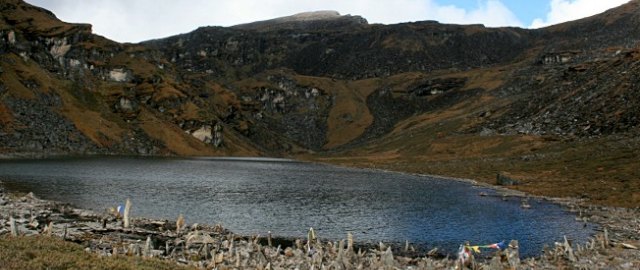
Duration : 15 Days
Route : Nambu → Sangkhola → Naya Patal → Lower Yambong → Upper Yambong → Gomathang → Panding → Dzongri → Lamune → Zemathang → Thansing → Tshoka → Yuksom → Uttarey → Gangtok
This Sikkim Trek passes through the evergreen Singalila range which spans across the borders of West Bengal, Sikkim and Nepal. Verdant valleys, gushing rivers, dazzling lakes, thick forests teeming with wildlife and birds characterize this stupendous mountain range. Yambong valley is one such treasure trove tucked in a remote part of West Sikkim. From its upper reaches emanates the Rimbi river which gushes through the valley.
The mountain slopes house dense temperate forests with birds and flowers. The upper reaches of the ridge are home to the Monal pheasant, a very colorful bird. Stupendous views of the Khangchendzonga and Everest ranges beckon us from top of the ridge. From here our trek traverses on to Dzongri where it meets the regular Goecha La trek. We now find ourselves in the lap of the mighty Khangchendzonga admiring its strength and beauty. After having our fill of this magnificent mountain we move down towards Yuksom through rich forests teeming with life.
Trek Grade : This trek is graded as Difficult.
Suitable for the experienced only. Hikes are lengthy and mostly over varied terrain. There is considerable height gain daily. These treks may be up to 15 days of trekking with 6-8 hrs (avg.) of walking each day. Altitudes regularly reach up to 15,000 feet and may reach up to 19,000 feet.
Best Season : April to May and mid October to early December for spectacular mountain views.
Itinerary
Day 1 Nambu
Pickup from from Bagdogra / NJP / Gangtok, drive to trek base village Nambu.
Day 2 Sangkhola
Trek for 4 hours to reach Sangkhola.
Day 3 Naya Patal
Trek for 5 hours to reach Naya Patal.
Day 4 Lower Yambong
Trek for 7 hours to reach Lower Yambong.
Day 5 Upper Yambong
Trek for 3 hours to reach Upper Yambong.
Day 6 Upper Yambong
Rest day.
Day 7 Gomathang
Trek for 6 hours to reach Gomathang.
Day 8 Panding
Trek for 6 hours to reach Panding.
Day 9 Dzongri
Trek for 5 hours to reach Dzongri.
Day 10 Lamune
Trek for 6 hours to reach Lamune.
Day 11 Zemathang
Trek for 6 hours to reach Zemathang.
Day 12 Thansing
Trek for 10 hours to reach Thansing via Goecha La.
Day 13 Tshoka
Trek for 5 hours to reach Tshoka.
Day 14 Yuksom
Trek for 5 hours to reach Yuksom.
Day 15 Gangtok / NJP
Drive to Gangtok / NJP for your connections.
Community Initiative :
Traditionally, nomadic yak herding and trade in medicinal and aromatic plants were the main source of livelihood for the villagers in the Yambong Singalila region. Albeit over grazing by the yak herds over a period of time became the single largest threat to the fragile alpine ecosystem. Further, use of Rhododendron and Juniper in large quantities for firewood, poaching of wildlife and smuggling of endangered medicinal plants were increasingly threatening the environment.
In early 2005 TMI- India (The Mountain Institute) initiated a community based tourism project to provide the local people with an alternative means of livelihood. The local communities put in a joint effort to promote tourism along the Yambong Singalila Trek. The Yambong Ecotourism Committee (YEC) was initially constituted to manage this initiative. A total of 146 porters were enlisted from the neighboring villages and several trainings for developing guides and cooks were undertaken. All yak herders and ranchers were made a part of this tourism venture and associated with Yambong Ecotourism Committee. In 2005, there were more than 1200 yak grazing in the alpine meadows, but after sensitizing the herders about the negative environmental impacts of over grazing, the number of yaks went down by 50% in just one year. Today there are only 100 odd yaks as the herders have realized that they can earn almost the same income from tourism related services as they used to earn from herding in 12 months. The herders who used to depend on natural resources are now earning income in a non-extractive manner. They also realize that sustenance of tourism is interconnected with the preservation of the environment, giving them an incentive to maintain the ecosystem.


No comments yet.